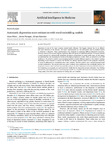Mostrar o rexistro simple do ítem
Automatic depression score estimation with word embedding models
| dc.contributor.advisor | ||
| dc.contributor.author | Pérez, Anxo | |
| dc.contributor.author | Parapar, Javier | |
| dc.contributor.author | Barreiro, Álvaro | |
| dc.date.accessioned | 2022-12-30T12:13:24Z | |
| dc.date.available | 2022-12-30T12:13:24Z | |
| dc.date.issued | 2022 | |
| dc.identifier.citation | A. Pérez, J. Parapar, and Á. Barreiro, “Automatic depression score estimation with word embedding models,” vol. 132, p. 102380, 2022, doi: 10.1016/j.artmed.2022.102380 | es_ES |
| dc.identifier.uri | http://hdl.handle.net/2183/32264 | |
| dc.description | Financiado para publicación en acceso aberto: Universidade da Coruna/CISUG | gl |
| dc.description.abstract | [Abstract]: Depression is one of the most common mental health illnesses. The biggest obstacle lies in an efficient and early detection of the disorder. Self-report questionnaires are the instruments used by medical experts to elaborate a diagnosis. These questionnaires were designed by analyzing different depressive symptoms. However, factors such as social stigmas negatively affect the success of traditional methods. This paper presents a novel approach for automatically estimating the degree of depression in social media users. In this regard, we addressed the task Measuring the Severity of the Signs of Depression of eRisk 2020, an initiative in the CLEF Conference. We aimed to explore neural language models to exploit different aspects of the subject’s writings depending on the symptom to capture. We devised two distinct methods based on the symptoms’ sensitivity in terms of willingness on commenting about them publicly. The first exploits users’ general language based on their publications. The second seeks more direct evidence from publications that specifically mention the symptoms concerns. Both methods automatically estimate the Beck Depression Inventory (BDI-II) total score. For evaluating our proposals, we used benchmark Reddit data for depression severity estimation. Our findings showed that approaches based on neural language models are a feasible alternative for estimating depression rating scales, even when small amounts of training data are available. | es_ES |
| dc.description.sponsorship | Ministerio de Ciencia e Innovación, Agencia Estatal de Investigación; RTI-2018-093336-B-C22 | es_ES |
| dc.description.sponsorship | Ministerio de Ciencia e Innovación, Agencia Estatal de Investigación; PLEC2021-007662 (MCIN/AEI/10.13039/501100011033) | es_ES |
| dc.description.sponsorship | Consellería de Educación, Universidade e Formación Profesional; ED431G/01 2019–2022 | es_ES |
| dc.description.sponsorship | Consellería de Educación, Universidade e Formación Profesional; GPC ED431B 2022/33 | es_ES |
| dc.description.sponsorship | Xunta de Galicia;ED481 A 2021/034 | es_ES |
| dc.language.iso | eng | es_ES |
| dc.publisher | Elsevier | es_ES |
| dc.relation.uri | https://doi.org/10.1016/j.artmed.2022.102380 | es_ES |
| dc.rights | Atribución-NoComercial-SinDerivadas 4.0 Internacional | es_ES |
| dc.rights.uri | http://creativecommons.org/licenses/by-nc-nd/3.0/es/ | * |
| dc.subject | Depression prediction | es_ES |
| dc.subject | Neural language models | es_ES |
| dc.subject | Social media | es_ES |
| dc.subject | Word embeddings | es_ES |
| dc.title | Automatic depression score estimation with word embedding models | es_ES |
| dc.type | info:eu-repo/semantics/article | es_ES |
| dc.rights.access | info:eu-repo/semantics/openAccess | es_ES |
| UDC.journalTitle | Artificial Intelligence In Medicine | es_ES |
| UDC.volume | 132 | es_ES |
| UDC.startPage | 102380 | es_ES |
| dc.identifier.doi | https://doi.org/10.1016/j.artmed.2022.102380 |
Ficheiros no ítem
Este ítem aparece na(s) seguinte(s) colección(s)
-
GI-IRlab-Artigos [27]






